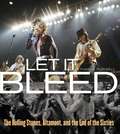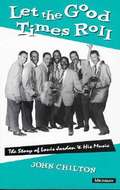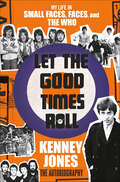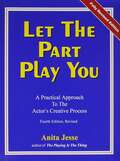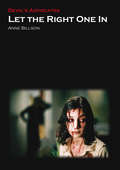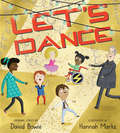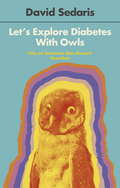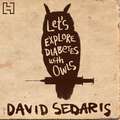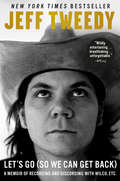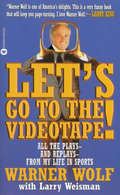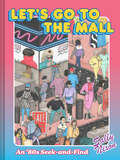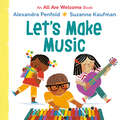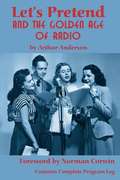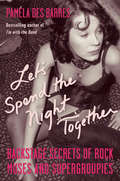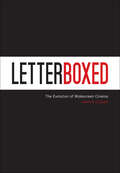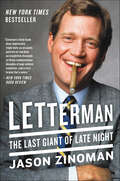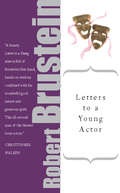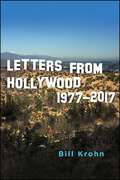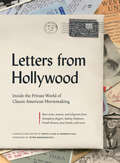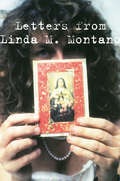- Table View
- List View
Let it Bleed: The Rolling Stones, Altamont, and the End of the Sixties
by Gerard Van Der Leun Ethan A. RussellLET IT BLEED takes you where no Rolling Stones book has before. Author and photographer Ethan Russell was one of only sixteen people--including the Rolling Stones--who made up the 1969 tour. He was with them in their hotel rooms, at rehearsals, and on stage. He tells the story of this monumental and historic tour firsthand, including recollections from band members, crew, security, and other sixties icons--like Abbie Hoffman and Little Richard--they met along the way. And he also includes amazing photos of the performers who toured with the Stones that year: the legendary Tina Turner and B. B. King. Through vivid quotes taken from his interviews with the band and crew, and through more than 220 revealing photographs, Russell takes you behind the scenes for an uncensored look inside the Rolling Stones' world at the end of the sixties. It was an idealistic time, with an overarching belief that music could bring us all together. But the events that led to the terrible violence and stabbing death at Altamont would change rock and roll forever.
Let the Good Times Roll: My Life in Small Faces, Faces, and The Who
by Kenney Jones“Jones, the drummer for the Who after Keith Moon died, recalls his musical life in this modest and self-effacing rock and roll memoir.” —Publishers WeeklyFrom the Mod revolution and the British Invasion of the 1960s, through the psychedelic era of the 1970s, and into the exuberance and excesses of stadium rock in the 1980s, Kenney Jones helped to build rock and roll as we know it. He was the beat behind three of the world’s most enduring and significant bands.He wasn’t just in the right place at the right time. Along with Keith Moon, John Bonham, and Charlie Watts, Jones is regarded as one of the greatest drummers of all time, sought after by a wide variety of the best-known and best-selling artists to bring his unique skill into the studio for the recording of classic albums and songs—including, of course, the Rolling Stones’s “It’s Only Rock ‘n’ Roll (But I Like It).”And Jones is no shallow rock star. He may play polo with royalty from across the globe now, but this is the story of a ragamuffin from the East End of London, a boy who watched his bandmates, friends since his teens, die early, combated dyslexia to find a medium in which he could uniquely excel, and later found a way through the wilderness years when the good times seemed to have gone and he had little to fall back on.Kenney Jones has seen it all, played with everyone, and partied with all of them. Let the Good Times Roll is a breathtaking immersion into music past that leaves readers feeling as if they lived it too.
Let the Part Play You: A Practical Approach to the Actor's Creative Process (4th edition, Revised)
by Anita JesseA useful book for those looking to get into the art of acting, this book, irrespective of being amateurs or veterans, will be extremely helpful and guiding to anyone with questions. It has personalized practices, which do not require multiple people and is tailored to your specific focus in the acting world. The book is great mentor to the art that you are already crafting.
Let the Right One In
by Anne BillsonAudiences can't get enough of fang fiction. Twilight, True Blood, Being Human, The Vampire Diaries, Buffy the Vampire Slayer, Blade, Underworld, and the novels of Anne Rice and Darren Shan& mdash;against this glut of bloodsuckers, it takes an incredible film to make a name for itself. Directed by Tomas Alfredson and adapted for the screen by John Ajvide Lindqvist, The Swedish film Làt den rätte komma in (2008), known to American audiences as Let the Right One In, is the most exciting, subversive, and original horror production since the genre's best-known works of the 1970s. Like Twilight, Let the Right One In is a love story between a human and a vampire& mdash;but that is where the resemblance ends. Set in a snowy, surburban housing estate in 1980s Stockholm, the film combines supernatural elements with social realism. It features Oskar, a lonely, bullied child, and Eli, the girl next door. "Oskar, I'm not a girl," she tells him, and she's not kidding& mdash;she's a vampire. The two forge an intense relationship that is at once innocent and disturbing. Two outsiders against the world, one of these outsiders is, essentially, a serial killer. What does Eli want from Oskar? Simple companionship, or something else? While startlingly original, Let the Right One In could not have existed without the near century of vampire cinema that preceded it. Anne Billson reviews this history and the film's inheritence of (and new twists on) such classics as Nosferatu (1979) and Dracula (1931). She discusses the genre's early fliration with social realism in films such as Martin (1977) and Near Dark (1987), along with its adaptation of mythology to the modern world, and she examines the changing relationship between vampires and humans, the role of the vampire's assistant, and the enduring figure of vampires in popular culture.
Let the Right One In
by Anne BillsonAudiences can't get enough of fang fiction. Twilight, True Blood, Being Human, The Vampire Diaries, Buffy the Vampire Slayer, Blade, Underworld, and the novels of Anne Rice and Darren Shan& mdash;against this glut of bloodsuckers, it takes an incredible film to make a name for itself. Directed by Tomas Alfredson and adapted for the screen by John Ajvide Lindqvist, The Swedish film Làt den rätte komma in (2008), known to American audiences as Let the Right One In, is the most exciting, subversive, and original horror production since the genre's best-known works of the 1970s. Like Twilight, Let the Right One In is a love story between a human and a vampire& mdash;but that is where the resemblance ends. Set in a snowy, surburban housing estate in 1980s Stockholm, the film combines supernatural elements with social realism. It features Oskar, a lonely, bullied child, and Eli, the girl next door. "Oskar, I'm not a girl," she tells him, and she's not kidding& mdash;she's a vampire. The two forge an intense relationship that is at once innocent and disturbing. Two outsiders against the world, one of these outsiders is, essentially, a serial killer. What does Eli want from Oskar? Simple companionship, or something else? While startlingly original, Let the Right One In could not have existed without the near century of vampire cinema that preceded it. Anne Billson reviews this history and the film's inheritence of (and new twists on) such classics as Nosferatu (1979) and Dracula (1931). She discusses the genre's early fliration with social realism in films such as Martin (1977) and Near Dark (1987), along with its adaptation of mythology to the modern world, and she examines the changing relationship between vampires and humans, the role of the vampire's assistant, and the enduring figure of vampires in popular culture.
Let the Right One In
by Anne BillsonAudiences can't get enough of fang fiction. Twilight, True Blood, Being Human, The Vampire Diaries, Buffy the Vampire Slayer, Blade, Underworld, and the novels of Anne Rice and Darren Shan—against this glut of bloodsuckers, it takes an incredible film to make a name for itself. Directed by Tomas Alfredson and adapted for the screen by John Ajvide Lindqvist, The Swedish film Làt den rätte komma in (2008), known to American audiences as Let the Right One In, is the most exciting, subversive, and original horror production since the genre's best-known works of the 1970s. Like Twilight, Let the Right One In is a love story between a human and a vampire—but that is where the resemblance ends. Set in a snowy, surburban housing estate in 1980s Stockholm, the film combines supernatural elements with social realism. It features Oskar, a lonely, bullied child, and Eli, the girl next door. "Oskar, I'm not a girl," she tells him, and she's not kidding—she's a vampire. The two forge an intense relationship that is at once innocent and disturbing. Two outsiders against the world, one of these outsiders is, essentially, a serial killer. What does Eli want from Oskar? Simple companionship, or something else? While startlingly original, Let the Right One In could not have existed without the near century of vampire cinema that preceded it. Anne Billson reviews this history and the film's inheritence of (and new twists on) such classics as Nosferatu (1979) and Dracula (1931). She discusses the genre's early fliration with social realism in films such as Martin (1977) and Near Dark (1987), along with its adaptation of mythology to the modern world, and she examines the changing relationship between vampires and humans, the role of the vampire's assistant, and the enduring figure of vampires in popular culture.
Let's Dance
by David BowieFor David Bowie fans young and old comes a very special picture book celebrating dancing and being joyful while paying homage to an iconic musical figure."Let's dance. Put on your red shoes and dance the blues..." Embrace the spirit and mood of iconic musician David Bowie in this must-have book for any Bowie fan, especially those wanting to introduce a new generation to a favorite musical artist. Lightly adapting the lyrics to "Let's Dance" for a younger audience, kids and parents will soon be tapping their shoes to this lively book with bright, fun, whimsical artwork.
Let's Dance!
by Valerie BollingThis rhythmic showcase of dances from all over the world features children of diverse backgrounds and abilities tapping, spinning, and boogying away!Tap, twirl, twist, spin! With musical, rhyming text, author Valerie Bolling shines a spotlight on dances from across the globe, while energetic art from Maine Diaz shows off all the moves and the diverse people who do them. From the cha cha of Cuba to the stepping of Ireland, kids will want to leap, dip, and zip along with the dances on the page!
Let's Do It: The Authorised Biography of Victoria Wood
by Jasper ReesTrapeze audiobooks presents an extraordinary multi-voice tribute to one of Britain's most talented and most loved entertainers: Victoria Wood.This audiobook features narration from some of the extraordinary voices who worked with Victoria over her career:Susie BlakeRichenda CareyCelia ImrieDuncan PrestonAnne ReidDaniel RigbyKate RobbinsDavid ThrelfallJulie WaltersJane WymarkWith an introduction read by Jasper Rees and two recordings of Victoria Wood's classic Ballad of Barry and Freda.'I was born with a warped sense of humour and when I was carried home from being born it was Coronation Day and so I was called Victoria but you are not supposed to know who wrote this anyway it is about time I unleashed my pent-up emotions in a bitter comment on the state of our society but it's not quite me so I think I shall write a heart-warming story with laughter behind the tears and tears behind the laughter which means hysterics to you Philistines...'From 'Pardon?' by Vicky Wood, Aged 14. Bury Grammar School (Girls) Magazine, 1967In her passport Victoria Wood listed her occupation as 'entertainer' - and in stand-up and sketches, songs and sitcom, musicals and dramas, she became the greatest entertainer of the age. Those things that might have held her back - her lonely childhood, her crippling shyness and above all the disadvantage of being a woman in a male-run industry - she turned to her advantage to make extraordinary comedy about ordinary people living ordinary lives in ordinary bodies. She wasn't fond of the term, but Victoria Wood truly was a national treasure - and her loss is still keenly felt. Victoria had plenty of stories still to tell when she died in 2016, and one of those was her own autobiography. 'I will do it one day,' she told the author and journalist Jasper Rees. 'It would be about my childhood, about my first few years in showbusiness, which were really interesting and would make a really nice story.' That sadly never came to pass, so Victoria's estate has asked Jasper Rees, who interviewed her more than anyone else, to tell her extraordinary story in full. He has been granted complete and exclusive access to Victoria's rich archive of personal and professional material, and has conducted over 200 interviews with her family, friends and colleagues - among them Victoria's children, her sisters, her ex-husband Geoffrey Durham, Julie Walters, Celia Imrie, Dawn French, Anne Reid, Imelda Staunton and many more. What emerges is a portrait of a true pioneer who spoke to her audience like no one before or since.
Let's Explore Diabetes With Owls
by David SedarisA guy walks into a bar . . . From here the story could take many turns. A guy walks into a bar and meets the love of his life. A guy walks into a bar and finds no one else is there. When this guy is David Sedaris, the possibilities are endless. In Let's Explore Diabetes with Owls, Sedaris delights with twists of humour and intelligence, remembering his father's dinnertime attire (shirtsleeves and underpants) his first colonoscopy (remarkably pleasant) and the time he considered buying the skeleton of a murdered pygmy. By turns hilarious and moving, David Sedaris masterfully looks at life's absurdities as he takes us on adventures that are not to be forgotten.
Let's Explore Diabetes With Owls
by David SedarisFrom the unique perspective of David Sedaris comes a new book of essays taking his readers on a bizarre and stimulating world tour. From the perils of French dentistry to the eating habits of the Australian kookaburra, from the squat-style toilets of Beijing to the particular wilderness of a North Carolina Costco, we learn about the absurdity and delight of a curious traveler's experiences. Whether railing against the habits of litterers in the English countryside or marveling over a disembodied human arm in a taxidermist's shop, Sedaris takes us on side-splitting adventures that are not to be forgotten.
Let's Go (So We Can Get Back): A Memoir of Recording and Discording with Wilco, Etc.
by Jeff TweedyThe singer, guitarist, and songwriter—best known for his work with Wilco—opens up about his past, his songs, the music, and the people that have inspired him.Few bands have inspired as much devotion as the Chicago rock band Wilco, and it's thanks, in large part, to the band's singer, songwriter, and guiding light: Jeff Tweedy. But while his songs and music have been endlessly discussed and analyzed, Jeff has rarely talked so directly about himself, his life, and his artistic process.Until now. In his long-awaited memoir, Jeff will tell stories about his childhood in Belleville, Illinois; the St. Louis record store, rock clubs, and live-music circuit that sparked his songwriting and performing career; and the Chicago scene that brought it all together. He'll also talk in-depth about his collaborators in Uncle Tupelo, Wilco, and more; and write lovingly about his parents, wife Susie, and sons, Spencer and Sammy. Honest, funny, and disarming, Tweedy's memoir will bring readers inside both his life and his musical process, illuminating his singular genius and sharing his story, voice, and perspective for the first time.
Let's Go To The Videotape!: All the Plays and Replays from My Life in Sports
by Larry Weisman Warner WolfEvery sports fan in America knows this legendary catchphrase, and it's all thanks to the dynamic commentary of sportscaster Warner Wolf. Here, in a book as colorful and good-humored as he is, Warner presents a sports feast of quirky observations, quotes, memories, debates, and trivia. Book jacket.
Let's Go to the Mall: A Seek-and-Find Trip Back to the ’80s
by Sally NixonPut on your roller skates and relive the 1980s in this fantabulous activity book for adults and teens.This retro twist on the seek-and-find book features 20 radical scenes of life in the eighties. Explore burger joints, video rental stores, and high school lunch tables, keeping an eye out for fanny packs, cassette players, and other fun hidden objects along the way. Delightfully detailed illustrations offer hours of entertainment, turning a nostalgic childhood activity into a perfect way to unwind after work or chill out with friends.EIGHTIES NOSTALGIA: This is a perfect gift for adults who lived through the eighties and young people who are fascinated by retro aesthetics. Anyone who’s obsessed with the worlds of Stranger Things, Freaks and Geeks, and The Goldbergs will have endless fun poring over this activity book, which is full of clever references to the era. WHERE'S WALDO REIMAGINED: Revisit a classic childhood activity with a sophisticated twist. This modern update features 20 gorgeous, immersive, highly detailed scenes, woven together by a light narrative. It's a book you'll return to over and over, to admire the art and enjoy the retro atmosphere. ANALOG ACTIVITY: When you need a screen break and want to unplug, this book provides hours of fun as an individual activity or with a group of friends! Throw an eighties-themed party and work together on this seek-and-find for a totally tubular time.Perfect for:Activity book and puzzle fansFans of eighties aestheticsAdults nostalgic for their youth and young people captivated by retro trendsLogic and brain game enthusiastsAnyone looking for a fun group activity to share with family or friendsFans of Sally Nixon and Houseplants and Hot SauceIllustration lovers
Let's Go to the Theater! (Houghton Mifflin Harcourt Vocabulary Readers #Leveled Reader: Level: 4, Theme: 2.5)
by Kate McgovernIntroduction to what goes into putting on a play: backstage and onstage.
Let's Make Music (All Are Welcome)
by Alexandra PenfoldDance to the rhythm of music with the beloved characters from the New York Times bestseller All Are Welcome! A joyous exploration of musical instruments and sounds, perfect for toddlers.Clap your hands. Tap your feet. It&’s time to make some music! Strum the guitar, shake the maracas, and dance to the beat of the drums with the kids from All Are Welcome! A read-out-loud celebration of music and sounds that will have the littlest of readers tapping their feet.
Let's Pretend and the Golden Age of Radio
by Arthur AndersonWelcome to the new, improved and expanded biography of everyone's favorite radio show, Let's Pretend, now containing a complete log of the series by radio historians Martin Grams, Jr. and Derek Tague. Arthur Anderson, an actor for 69 years, started playing character roles for Nila Mack on Let's Pretend at age 13, and was on it almost every week (with time out for military service) until the program's demise. He played the boy Lucius in Orson Welles' spectacular Broadway production of Julius Caesar, and was then in Welles' Mercury Theatre on the Air on CBS. He was most recently the voice of the nasty farmer Eustace in the TV cartoon series Courage, the Cowardly Dog, but he's most proud of his 29 years as the original voice of the Lucky Charms (cereal) Leprechaun.
Let's Spend the Night Together: Backstage Secrets of Rock Muses and Supergroupies
by Pamela Des BarresThis intimate account of 24 legendary groupies reveals what went on behind the closed doors of rock stars from Elvis to Marilyn Manson. Consisting of Pamela Des Barres's revealing interviews with and profiles of other supergroupies, this book offers firsthand glimpses into the backstage world of rock stars and the women who loved them. The groupies--such as Tura Satana, Miss Japan Beautiful, who taught Elvis how to dance; Cassandra Peterson (Mistress of the Dark), who tangled with Tom Jones in Sin City; Cynthia Plaster Caster, who redefined the art of Jimi Hendrix; and Miss B., who revealed Kurt Cobain's penchant for lip gloss and panty hose--tell tales that go well beyond an account of a one-night stand to become a part of music history.
Letterboxed: The Evolution of Widescreen Cinema
by Harper CossarWhen widescreen technology was introduced to filmmaking in 1953, it changed the visual framework and aesthetic qualities of cinema forever. Before widescreen, a director's vision for capturing beautiful landscapes or city skylines was limited by what coul
Letterman: The Last Giant of Late Night
by Jason ZinomanNew York Times comedy critic Jason Zinoman delivers the definitive story of the life and artistic legacy of David Letterman, the greatest television talk show host of all time and the signature comedic voice of a generation.In a career spanning more than thirty years, David Letterman redefined the modern talk show with an ironic comic style that transcended traditional television. While he remains one of the most famous stars in America, he is a remote, even reclusive, figure whose career is widely misunderstood. In Letterman, Jason Zinoman, the first comedy critic in the history of the New York Times, mixes groundbreaking reporting with unprecedented access and probing critical analysis to explain the unique entertainer’s titanic legacy. Moving from his early days in Indiana to his retirement, Zinoman goes behind the scenes of Letterman’s television career to illuminate the origins of his revolutionary comedy, its overlooked influences, and how his work intersects with and reveals his famously eccentric personality. Zinoman argues that Letterman had three great artistic periods, each distinct and part of his evolution. As he examines key broadcasting moments—"Stupid Pet Tricks" and other captivating segments that defined Late Night with David Letterman—he illuminates Letterman’s relationship to his writers, and in particular, the show’s co-creator, Merrill Markoe, with whom Letterman shared a long professional and personal connection.To understand popular culture today, it’s necessary to understand David Letterman. With this revealing biography, Zinoman offers a perceptive analysis of the man and the artist whose ironic voice and caustic meta-humor was critical to an entire generation of comedians and viewers—and whose singular style ushered in new tropes that have become clichés in comedy today.
Letters To A Young Actor
by Robert BrusteinThe founder and director of the Yale Repertory Theater, as well as Harvard’s American Repertory Theater, and a drama critic for more than thirty years, Robert Brustein is a living legend in theatrical circles. Letters to a Young Actor not only inspires the multitudes of struggling dramatists out pounding the pavement, but also reinvigorates the very state of the art of acting itself.
Letters from Hollywood: 1977-2017 (SUNY series, Horizons of Cinema)
by Bill KrohnJournalist and filmmaker Bill Krohn has been the Los Angeles correspondent for the French magazine Cahiers du cinéma for over forty years. Letters from Hollywood brings together thirty-four of his essays, many of them appearing in English for the first time. Focusing most pieces on a particular director and film, Krohn uses his inside knowledge of the studio system to illuminate an art that is also a multibillion-dollar business. He connects currents in French film criticism and theory with an unfolding account of American cinema past and present, offering penetrating insights into directors and their work. Beginning with Allan Dwan, who learned how to make movies before Hollywood was born by watching D. W. Griffith, Krohn presents a panorama that encompasses Alfred Hitchcock and Woody Allen, Stanley Kubrick and Sergio Leone, Star Wars and I Love Lucy. He covers everything from gangsters to gremlins, from blockbusters to no-budget cult films like Moon Over Harlem and Plan 9 from Outer Space, in a style that is accessible to anyone who loves movies, or has a passion for writing about them.
Letters from Hollywood: Inside the Private World of Classic American Moviemaking
by Rocky Lang; Barbara HallRare correspondence from Humphrey Bogart, Audrey Hepburn, Frank Sinatra, Jane Fonda, and other Hollywood luminaries from the silent film era to the 1970s. Letters from Hollywood reproduces in full color scores of entertaining and insightful pieces of correspondence from some of the most notable and talented film industry names of all time—from the silent era to the golden age, and up through the pre-email days of the 1970s. Culled from libraries, archives, and personal collections, the 135 letters, memos, and telegrams are organized chronologically and are annotated by the authors to provide backstories and further context. While each piece reveals a specific moment in time, taken together, the letters convey a bigger picture of Hollywood history. Contributors include celebrities like Greta Garbo, Alfred Hitchcock, Humphrey Bogart, Frank Sinatra, Katharine Hepburn, Marlon Brando, Elia Kazan, Cary Grant, Francis Ford Coppola, Tom Hanks, and Jane Fonda. This is the gift book of the season for fans of classic Hollywood.With a foreword by Peter Bogdanovitch.“This is, quite simply, one of the finest books I’ve ever read about Hollywood.” —Leonard Maltin
Letters from Linda M. Montano
by Linda M. MontanoLetters from Linda M. Montano is an anthology of writings by one of the seminal performance artists of the last century. It provides an autobiographical and historical record of Montano's artistic practice over the last thirty years, collecting together stories, fairytales, letters, interviews, manifestos and other previously unpublished writings. At the same time, the book acts as a 'how-to' manual for aspiring performance artists, offering practical guidance for students and a range of exercises that Montano has used in her teachings and workshops. Finally, Letters from Linda M. Montano represents a performance in itself, in which the artist considers the process of writing, creating and bringing the work to fruition as another form of 'endurance performance' similar to that of her durational works 14 Years of Living Art and Blood Family Art. COVER PHOTO COURTESY OF GISELA GAMPER.
